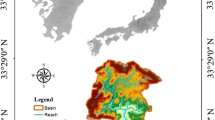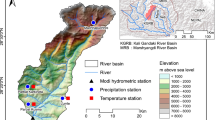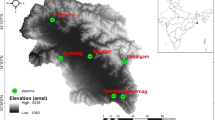Abstract
This study intends to disclose orographic effects on climate and climatic impacts on hydrological regimes in Qinling Mountains under global change background. We integrate a meteorological model (MM5 model, PSU/NCAR, 2005) and a hydrological model (SWAT model, 2005) to couple hydrological dynamic with climate change in Qinling Mountains. Models are calibrated and validated based on the simulation of different combined schemes. Following findings were achieved. Firstly, Qinling Mountains dominantly influence climate, and hydrological process in Weihe River and upper Hanjiang River. Results show that Qinling Mountains lead to a strong north–south gradient precipitation distribution over Qinling Mountains due to orographic effects, and it reduces precipitation from 10–25 mm (December) to 55–80 mm (August) in Weihe River basin, and adds 25–50 mm (December) or 65–112 mm (August) in upper Hanjiang River basin; evapotranspiration (ET) decrease of 21% in Weihe River (August) and increase 10.5% in upper Hanjiang River (July). The Qinling Mountains reduce water yields of 23.5% in Weihe River, and decrease of 11.3% in upper Hanjiang River. Secondly, climate change is responsible for the changes of coupling effects of rainfall, land use and cover, river flow and water resources. It shows that average temperature significantly increased, and precipitation substantially reduced which leads to hydrological process changed greatly from 1950 to 2005: temperature increased and precipitation decreased, climate became drier in the past two decades (1980–2005), high levels of precipitation exists in mid-1950, mid-1970, while other studied periods are in low level states. The inter-annual variation in water yield correlates with surface runoff with an R 2 value of 0.63 (Weihe River) and 0.87 (upper Hanjiang River). It shows that variation of annual precipitation was smaller than that of seasonal precipitation.
Similar content being viewed by others
References
Arnold JG, Allen PM (1996) Estimating hydrologic budgets for three Illinois watersheds. J Hydrol 176:55–77
Arnold JG, Srinivasan R, Muttah RS, Williams JR (1998) Large area hydrologic modeling and assessment part I: model development. J Am Water Resour Assoc 34(1):73–89
Bacchi B, Ranzi R (eds) (2000) RAPHAEL—runoff and atmospheric processes for flood hazard forecasting and control. Final report to the EC, directorate general XII, Programme Environment and Climate, 1994–1998
Barros AP, Kuligowski RJ (1998) Orographic effects during a severe wintertime rainstorm in the Appalachian mountains. Mon Weather Rev 126:2648–2672
Barros AP, Lettenmaier DP (1994) Dynamic modeling of orographically-induced precipitation. Rev Geophys 32:265–284
Bhatti JS, Fleming RL, Foster NW, Meng FR, Bourque CPA, Arp P (2000) Simulations of pre- and post-harvest soil temperature, soil moisture, and snowpack for jack pine: comparison with field observations. For Ecol Manag 138(1–3):413–426
Bi B, Liu Y, Li Z (2004) Numerical simulations of extremely heavy rain in the southern Shaanxi Province during 8 and 9 June 2002. Chin J Atmos Sci 28(5):747–761 (in Chinese)
Bi B, Liu Y, Li Z (2005) Mesoscale system analysis of extremely heavy rainfall in the southern part of Shaanxi Province during 8 and 9 June 2002. Chin J Atmos Sci 29(5):814–826 (in Chinese)
Bindlish R, Barros AP (2000) Disaggregation of rainfall for one-way coupling of atmospheric and hydrological models in regions of complex terrain. Glob Planet Change 25:111–132
Bootsma A (1994) Long-term (100 YR) climatic trends for agriculture at selected locations in Canada. Clim Change 26:65–88
Bouraoui F, Benabdallah S, Jrad A, Bidoglio G (2005) Application of the SWAT model on the Medjerda river basin (Tunisia). Phys Chem Earth 30:497–507
Chen CS, Chena WC, Chen YL, Lina PL, Laic HC (2005) Investigation of orographic effects on two heavy rainfall events over southwestern Taiwan during the Mei-yu season. Atmos Res 73:101–130
Evans JP (2003) Improving the characteristics of streamflow modelled by regional climate models. J Hydrol 284:211–227
Giorgi F, Marinucci MR, Visconti G (1992) A 2×CO2 climate change scenario over Europe generated using a limited area model nested in a general circulation model: 2. Climate change scenario. J Geophys Res 97(D9):9989–10009
Hansen J, Lacis A, Rind D, Russell G, Stone P, Fung I, Ruedy R, Lerner J (1983) Climate sensitivity: analysis of feedback mechanisms in climate processes and climate sensitivity. Geophys Monogr 29:130
He H, Yu Q, Zhou J, Tian YQ (2008a) Modelling complex flood flow evolution in the Middle Yellow River China. J Hydrol 353:76–92
He H, Zhou J, Zhang W (2008b) Modelling the impacts of environmental changes on hydrological regimes in the Hei River Watershed, China. Glob Planet Change 61:175–193
He H, Zhou J, Yu Q, Tian YQ, Chen RF (2006) Flood frequency and routing processes at a confluence of the middle Yellow River in China. River Res Appl 22:1–21
Jasper K, Calanca P, Fuhrer J (2006) Changes in summertime soil water patterns in complex terrain due to climatic change. J Hydrol 327:550–563
Jimenez P, Jorba O, Parra R, Baldasano JM (2006) Evaluation of MM5-EMICAT2000-CMAQ performance and sensitivity in complex terrain: high-resolution application to the northeastern Iberian Peninsula. Atmos Environ 40(26):5056–5072
Kuhl SC, Miller JR (1992) Seasonal river runoff calculated from global atmospheric model. Water Resour Res 28(8):2029–2039
Kunstmann H, Stadler C (2005) High resolution distributed atmospheric-hydrological modelling for Alpine catchments. J Hydrol 314:105–124
Leung LR, Ghan SJ, Zhao ZC, Luo Y, Wang WC, Wei HL (1999) Intercomparison of regional climate simulations of the 1991 summer monsoon in eastern Asia. J Geophys Res 104(D6):6425–6454
Li J, Lu HC, Wang HJ, Zhu M, Zheng K (2004) A mesoscale analysis of heavy rain caused by frontal and topographical heterogeneities on Taiwan Island. Adv Atmos Sci 21(6):909–922
Liu YH (1983) Hydrography of Qinling Mountains (in Chinese). Shaanxi People’s Press, Xi’an
Marshall E, Randhir T (2008) Effect of climate change on watershed system: a regional analysis. Clim Change 89:263–280. doi:10.1007/s10584-007-9389-2
Menzel L, Burger G (2002) Climate change scenarios and runoff response in the Mulde. J Hydrol 267:53–64
Miller JR, Russell GL (1992) The impact of global warming on river runoff. J Geophys Res 97(D3):2757–2764
Milliman JD, Meade RH (1983) World-wide delivery of river sediment to the oceans. J Geol 91:1–21
Muleta MK, Nicklow JW (2005) Sensitivity and uncertainty analysis coupled with automatic calibration for a distributed watershed model. J Hydrol 306:127–145
Najjar RG (1999) The water balance of the Susquehanna River Basin and its response to climate change. J Hydrol 219:7–19
Nash JE, Sutcliffe JV (1970) River flow forecasting through conceptual models, part 1—a discussion of principles. J Hydrol 10(3):282–290
Osborn HB, Lane LJ (1969) Precipitation–runoff relationships for small semi-arid rangeland watersheds. Water Resour Res 5(2):419–425
Raymond PM, Wolfgang B (2005) Impacts of present and future climate change and climate variability on agriculture in the temperate regions: North America. Clim Change 70:137–164
Refsgaard JC (1997) Parameterization, calibration and validation of distributed hydrologic models. J Hydrol 198:69–97
Refsgaard JC, Knudsen J (1996) Operational validation and intercomparison of different types of hydrologic models. Water Resour Res 32(7):2189–2202
Ren LL,Wang MR, Li CH (2002) Impacts of human activity on river runoff in the northern area of China. J Hydrol 261:204–217
Russell G, Miller J (1990) Global river runoff calculated from a global atmospheric general circulation model. J Hydrol 117:241–254
Wagner S, Kunstmann H, B’ardossy A (2006) Model based distributed water balance monitoring of the White Volta catchment in West Africa through coupled meteorological–hydrological simulations. ADGEO 9:39–44
Wagner S, Kunstmann H, Bárdossy A, Conrad C, Colditz R (2008) Water balance estimation of a poorly gauged catchment in West Africa using dynamically downscaled meteorological fields and remote sensing information. Phys Chem Earth (in press). doi:10.1016/j.pce.2008.04.002
Wang Y, Wang G, Wang C (1998) Study on recent 10 years climate and surface river flow of Weihe River Basin. Yellow River (in Chinese) 20(10):4–7
Westrick K, Storck P, Mass C (2002) Description and evaluation of a hydrometeorological forecast system for mountainous watersheds. Weather Forecast 17:250–262
Whitehead PG, Robinson M (1993) Experimental basin studies—an international and historical perspective of forest impacts. J Hydrol 145:217–230
Wigmosta MS, Vail LW, Lettenmaier DP (1994) A distributed hydrology–soil–vegetation model for complex terrain. Water Resour Res 30:1665–1679
Wood EF, Sivaplan M, Beven K, Band L (1988) Effects of spatial variability and scale with implications to hydrologic modeling. J Hydrol 102:29–47
Woolhiser DA (1996) Search for physically based runoff model—a hydrologic El Dorado. J Hydraul Eng 3:122–129
Zhang N, Yu G, Yu Z (2003) Simulation of temporal–spatial variation characteristics of surface runoff in Changbai Mountain based on process model for landscape scale. J Appl Ecol (in Chinese) 14(5):653–658
Author information
Authors and Affiliations
Corresponding author
Rights and permissions
About this article
Cite this article
He, H., Zhang, Q., Zhou, J. et al. Coupling climate change with hydrological dynamic in Qinling Mountains, China. Climatic Change 94, 409–427 (2009). https://doi.org/10.1007/s10584-008-9527-5
Received:
Accepted:
Published:
Issue Date:
DOI: https://doi.org/10.1007/s10584-008-9527-5




